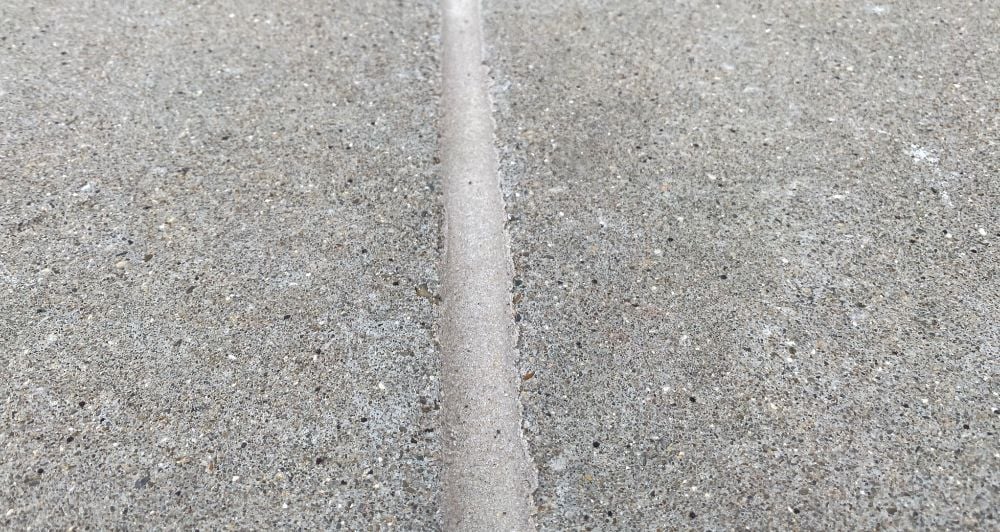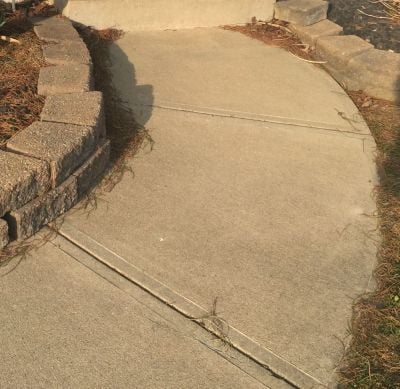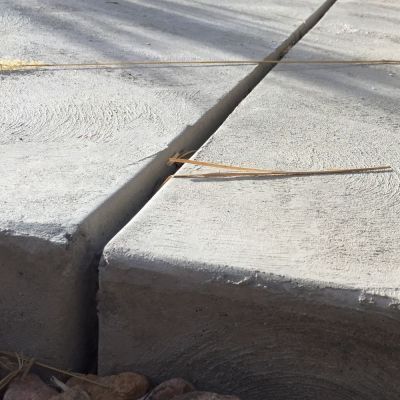Caulking Concrete Expansion and Control Joints: Should You Do It?
November 21st, 2022 | 3 min. read
By Sarah Etler

Learn the difference between concrete control joints and expansion joints, and when you should and shouldn’t caulk them.
If you’re worried about keeping your concrete in good shape, caulking its control joints and expansion joints can be a great way to do just that.
Caulking your concrete is a crucial step in the maintenance process to help prevent damage and settling from taking place.
A-1 Concrete Leveling has been in the concrete business for over thirty years, and during this time we’ve learned just how important it is to keep concrete joints caulked.
This article will take a look at the difference between control joints and expansion joints, discuss when you should caulk them, and give examples of when you shouldn’t caulk them.
Control Joints vs. Expansion Joints
Both control and expansion joints are very important to the structure of your concrete and play a huge part during the natural expansion and contraction of the slabs that happens as temperatures fluctuate.
Control Joints
Control joints are put in place to act as a place to “control” where the concrete breaks. These joints do not go all the way through the slab, but instead make a straight line at a partial depth.
This allows the slab to crack at that pre-decided point, and in a straight line, rather than at a random place in the slab.

Expansion Joints
Expansion joints are gaps left between concrete slabs and another object to allow for movement between them when they expand and contract. This takes pressure off of the moving slabs and prevents cracking due to this movement.
Expansion joints can be placed where one concrete slab meets another, where a slab meets the foundation of a building, where a concrete pool deck slab meets the pool coping, and more.

Should Control Joints and Expansion Joints Be Caulked?
In general, anywhere where water can get underneath the slab should be caulked. Sealing these areas can help prevent water from washing away the material holding up the slab.
This should be done as part of a regular maintenance routine, as water erosion is one of the main reasons concrete settles and can be avoided by caulking the gaps between concrete and by taking proper care to eliminate sources of potential excess water flow around your home.
In addition, if we lift your concrete, it’s a good idea to caulk any gaps so that water can’t enter and cause the slabs to settle again.
Caulking Control Joints
As mentioned above, caulking should seal up any place in the concrete where water can flow and erode what’s underneath. Unless the control joint has cracked, how it should over time by design, it is not necessary to caulk it.
With this being said, some homeowners request control joint caulking to keep a cohesive look throughout their concrete or as a preventative measure.
Caulking Expansion Joints
Because expansion joints are open gaps leading straight to the soil and sub-material under the concrete, they should always be caulked to prevent water from eroding away the base that the concrete is sitting on.
Cases Where You Shouldn’t Caulk Control Joints and Expansion Joints
Caulking control and expansion joints is a critical maintenance and damage prevention method, but it’s not always necessary, or even recommended. The following is a list of cases where concrete control and expansion joints should not be caulked:
-
If water isn’t a concern for you
If you live in an arid climate with almost no rainfall, or your concrete doesn’t experience a lot of runoff when it does rain, then caulking the control joints and expansion joints around your home to protect against water erosion probably isn’t necessary.
-
Around tree roots
Unless a tree is dead and will not keep growing, caulking the control or expansion joints around its roots will likely only be a temporary solution. As the roots grow and push the slab up, the caulk will break away from the slab and lose its ability to defend against water.
-
Inside garage interiors
The inside of your garage is an area without water flow, so caulking joints there is unnecessary unless done to eliminate trip hazards or to achieve a desired look.
While it’s true that, generally speaking, caulking in these areas isn’t necessary, it’s important to remember to keep safety in mind. If caulking a crack or break in one of these situations can fix a trip hazard or make your home safer in any way for your family and guests, it’s worth doing.
Now What?
Now that you’ve learned when and when not to caulk the control and expansion joints around your home, you’re ready to take action in order to preserve your concrete.
Depending on how handy you are, concrete caulking can be done as a DIY project, or you can hire experienced professionals to get the job done for you. A-1 Concrete Leveling offers concrete caulking as a service, as well as concrete cleaning and sealing, concrete leveling, and more.
If you’re interested in setting up a free onsite consultation and estimate with one of the A-1 Concrete Leveling experts, click the link below!
Click Here to Find Your Nearest Location and Receive a FREE Estimate
Our Concrete Academy has plenty of other resources about concrete maintenance and repair. Check out some of these related topics:
Sarah Etler joined A-1 Concrete Leveling after receiving her Bachelor of Arts degree in English from Northern Kentucky University. As A-1's Content Marketing Manager, she works closely with industry experts to produce content that will best answer questions related to concrete repair and maintenance practices. Sarah loves living a life full of discovery and is excited every day to see what new things she can learn and share with those around her.
Topics: